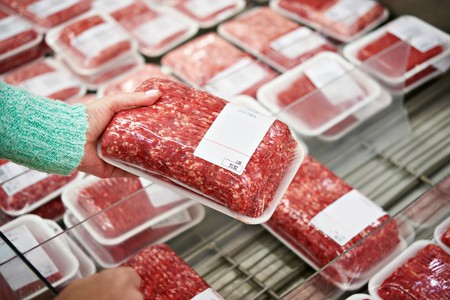Here’s how to save money buying meat, which is usually the single more expensive part of your grocery bill.
 Eating a well-prepared piece of meat is great, but what’s even greater is knowing how to save money buying meat. The following list explains a few tips and tricks you can use to maximize your meat buying ability.
Eating a well-prepared piece of meat is great, but what’s even greater is knowing how to save money buying meat. The following list explains a few tips and tricks you can use to maximize your meat buying ability.
Buy from a Wholesale Meat Supplier
You typically get your meat from your local grocery store, but have you ever thought about where your grocery store gets the meat? Usually, it’s from a local wholesale meat supplier. Believe it or not, you don’t have to be a grocery store to shop wholesale. Purchasing your meat from a wholesale supplier can result in notable savings. The only catch is that there won’t be as many wholesale meat suppliers as there are grocery stores and you’ll probably have to buy in bulk. However, this will get you enough meat to last several months.
Purchase a Share from a Local Farm
Local farms are more than willing to let anyone purchase a share of a farm animal, such as a hog or cow. A share can cost a few hundred to a few thousand dollars, depending on the share, size of the animal and type of animal. However, you can get enough meat to last for years if properly stored.
The drawbacks of buying a share are that the purchase is usually larger than many are willing to spend and your meat won’t be available immediately. Then there’s the fact that you’ll need to have enough storage space for the meat. But purchasing a share can save a tremendous amount of money and allows you to support the local economy. Besides that, you’ll know exactly where your meat comes from.
Shop at an Ethnic Grocery Store
These cost savings are most pronounced when you need to cook a meat dish that requires a cut of meat that’s uncommon at a grocery store. This means you either have to drive to a not-so-close grocery store to find the meat, or you need to pay a marked-up price to get the meat from your local grocery store’s meat department. Then there’s the fact that this rare cut of meat has such small demand, it’s probably not going to go on sale very often (if at all).
What’s the solution? Try visiting an ethnic grocery store. If your much-desired cut of meat is a staple ingredient in a particular country or culture’s dish, you may find it easily and affordably at an ethnic grocery store.
Buy Meat Based on your Grocery Store’s Circular
Each week, your local grocery store will probably have a sale on a particular type of meat. Often, this sale is seasonal, such as turkey in November and ham in April. By planning your meals several weeks to several months ahead of time and buying in bulk, you can purchase the meat that’s on sale each week and avoid paying full price.
Understand the Labeling
Recently, labels for store bought meat contain words such as “organic,” “grass fed” and “antibiotic free.” Meats with these labels typically have higher prices, but make sure you’re paying for something you truly want and not buying into marketing hype. For example, if you don’t care about organic meat, but you want your meat to be from a grass fed cow because you can taste the difference, then focus on grass fed and less on labels that claim the meat is antibiotic free or organic.
Buy Generic
Like most foods from the grocery store, generic is usually cheaper than name brand. Meat is no different. Unless there’s a specific characteristic about a brand name cut of meat that you must have, buy the store brand of meat. And if you’re curious, ask the grocer’s butcher or meat department manager where the meat comes from. Depending on the answer, you might be perfectly satisfied with the source of the generic meat without having to pay name brand prices.
If you’re working on learning how to save money buying meat, an auto pawn could help. Call your nearest Title Tree location for help now.
